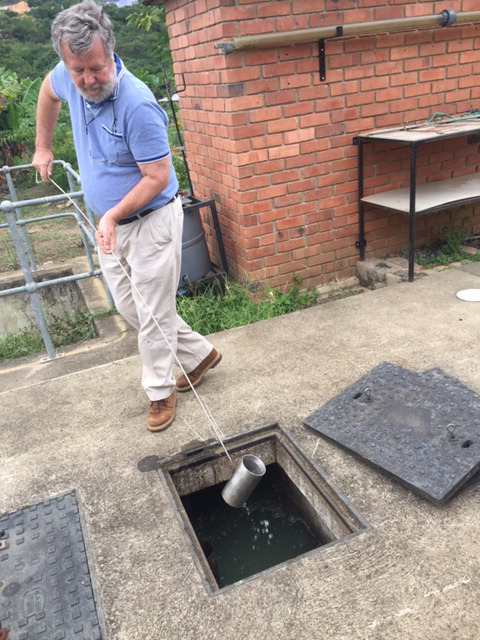Cycle 5 (2015 Deadline)
Developing exposure and toxicity data for trace organic chemicals in wastewater, biosolids, and soils
PI: Bice Martincigh (martinci@ukzn.ac.za), University of KwaZulu-Natal
U.S. Partner: Natalie Mladenov, San Diego State University
Project Dates: February 2017 - December 2021
Project Overview:
 | | Dr. Chris Buckley at the wastewater treatment plant at Newlands Mashu |
Contemporary lifestyles and the extensive use of organic chemicals in personal care and consumer products (PCCPs) leads to the constant discharge of enormous quantities of chemical residues from industries and homes into wastewater streams and, ultimately, the environment. In contrast to heavy metals, pathways of trace organic chemicals (TOrCs) derived from manufacturing and use of PCCPs are varied in the wastewater stream . The majority of TOrCs that reach wastewater treatment plants are destroyed through treatment and sludge processing, but recalcitrant TOrCs and their metabolites can pass through the treatment process intact and partition, dependent on their physico-chemical properties, in biosolids and aqueous media. Very little is known about the fate of TOrCs in the climatic context of South Africa.
This team has chosen to study a set of four classes of potential pollutants: flame retardants, the broad-spectrum herbicide glyphosate (Ro undup®, ubiquitously used in the local sugarcane industry), antibiotics, and HIV anti-retrovirals. Effluents from wastewater treatment plants in the Durban area, sewage sludge, biosolids, soils from effluent-irrigated farm land, and sludge and/or biosolid-amended soils will be analyzed and characterized for the presence of these TOrCs.
This project will have access to the local DEWATS wastewater treatment plant, which allows for detailed studies on the fate of the TOrCs during their passage through the plant and subsequent agricultural areas, providing a confined and controlled environment. Comprehensive target and non-target analytical techniques will be developed to detect and quantify the four classes of compounds in the selected matrices.
Furthermore, the team will develop a simultaneous extraction and clean-up method for each chemical compound class in the above-mentioned matrices.
Final Summary of Project Activities
This research project investigated the presence and behavior of trace organic chemicals (TOrCs) in wastewater and biosolids across South Africa, with a particular focus on compounds derived from everyday personal care and consumer products. These chemicals, including pharmaceuticals, herbicides such as glyphosate, and illicit drugs, are continually discharged into wastewater systems, leading to environmental contamination. Unlike heavy metals, TOrCs exhibit diverse pathways through wastewater treatment plants (WWTPs), where some are effectively removed while others persist through the treatment process and accumulate in biosolids and water bodies.
A critical aspect of the study was the examination of five WWTPs in the Durban area, assessing influents, effluents, biosolids, and biosolid-amended soils for the presence and concentration of TOrCs. Of particular interest was the comparison between conventional centralized WWTPs and decentralized DEWATS systems, which utilize longer residence times and anaerobic processes, potentially offering superior removal of TOrCs. This research underscored the importance of understanding treatment efficiencies and the environmental risks posed by residual TOrCs in various wastewater treatment contexts.
Moreover, the project delved into risk assessments of selected antibiotics, revealing potential hazards to aquatic organisms and the emergence of antimicrobial resistance in receiving rivers. The innovative use of wastewater-based epidemiology (WBE) provided real-time insights into community drug consumption patterns within the eThekwini Municipality, offering a novel approach to public health monitoring.
Scientifically, the project advanced analytical techniques for both targeted and non-targeted analysis of TOrCs in complex environmental matrices, aiding in comprehensive risk assessments and informing strategies for water reuse in water-scarce regions like South Africa. This development of analytical methodologies has broader implications for global water management practices.
Beyond scientific advancements, the project contributed significantly to human capital development by fostering doctoral and master's research, promoting knowledge exchange through international collaborations, and enhancing the capabilities of local water authorities in policy formulation and environmental stewardship. The PI's recognition, including election as a Fellow of the Royal Society of South Africa and leadership roles in international scientific conferences, underscores the project's impact and influence in the global scientific community.
Looking ahead, future research endeavors aim to innovate nanotechnology-based solutions for polishing wastewater effluents, exploring adsorption and chemical oxidation/reduction technologies. These efforts aim to enhance the removal efficiency of recalcitrant micropollutants, ensuring safer wastewater reuse and contributing to sustainable water management practices globally.
Publications
J.M. Nzangya, E.N. Ndunda, G.O. Bosire, B.S. Martincigh and V. O. Nyamori, Polybrominated Diphenyl Ethers (PBDEs) as Emerging Environmental Pollutants: Advances in Sample Preparation and Detection Techniques. In “Emerging Contaminants” edited by A. Nuro, IntechOpen, DOI: 10.5772/intechopen.93858.
M.M. Mwanza, E.N. Ndunda, G.O. Bosire, V.O. Nyamori and B.S. Martincigh, Advances in sample pretreatment and detection of PCBs in the environment. Journal of Hazardous Materials Advances, 4, 2021, 100028. DOI: 10.1016/j.hazadv.2021.100028
N. Mladenov, N.G. Dodder, L. Steinberg, W. Richardot, J. Johnson, B.S. Martincigh, C. Buckley, T. Lawrence and E. Hoh, Persistence and removal of trace organic compounds in centralized and decentralized wastewater treatment systems. Chemosphere, 286, 2022, 131621. DOI:10.1016/j.chemosphere.2021.131621
Back to PEER Cycle 5 Grant Recipients
|




